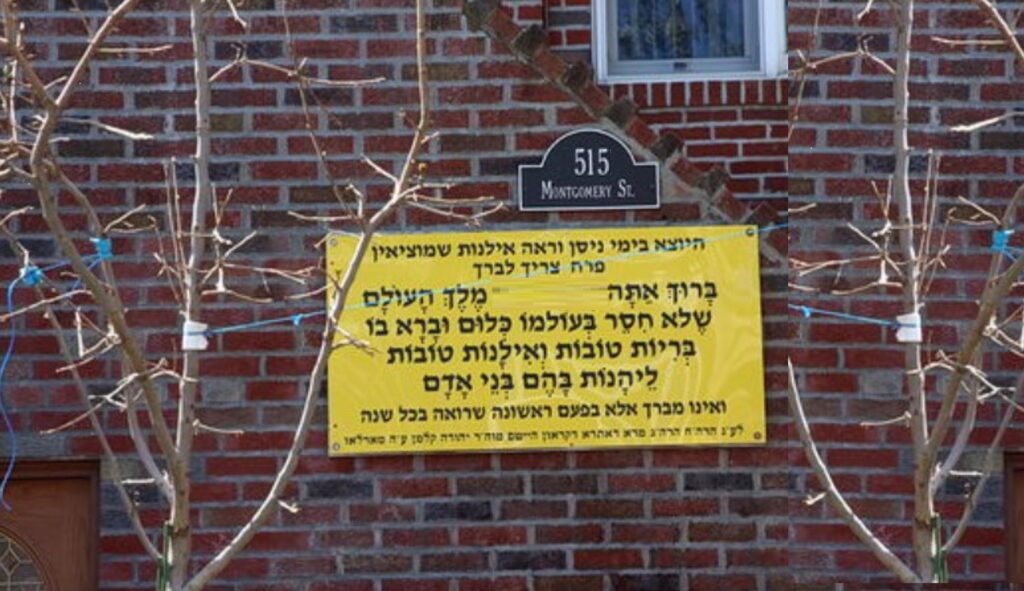By Rabbi Yair Hoffman for 5tjt.com
There are some very special people out there who make it their business to help people perform Mitzvos.
Pretty much everyone is familiar with the fruit tree bracha that is recited during the month of Nissan. But sometimes, it is difficult to find such a tree. These very special people, years ago, made sure to plant trees that would be available for people to recite the special Nissan Bracha.
HOW TO MAKE IT A DE’ORAISAH MITZVAH – NOT ONLY A DERABANAN
Let’s picture a yeshiva student, home for Pesach. We will call him, “Pini.” Pini learns well, applies himself diligently both to Torah study and the observance of Mitzvos. But Pini has one problem: He is allergic to certain types of trees. He is allergic to male trees.
Is there a Mitzvah then for those who post a bracha sign on their Nissan tree to also write: “Warning, this is a male tree – not a female tree. If you need a female tree go to 2440 Maple Road..”? Is this a fulfillment of V’ahavta l’rayacha kamocha? Is there a further hiddur in specifically planting only female trees for the bracha?
Male trees are the ones that produce pollen, while female ones do not [unless they also have male parts that do as well, which is not uncommon per se.]
This author believes that this addition to the sign would certainly be a further fulfillment of v’ahavta larayacha kamocha, (but will try to check with leading Poskim).
GENERAL BACKGROUND REGARDING THE BRACHA
The Gemorah in Brachos 43b states, “Hai man denafik beyomei Nissan vechazi elanei d’ka milbalvi omer… – A person who goes outside during the month of Nissan and sees trees that are blossoming, he recites the following blessing.. Baruch atah Hashem Elokainu melech haolam shelo chasar b’olamo klum u’bara bo b’riyos tovos v’ilanos tovim l’hanos bahem b’nay adam.
This Gemorah is codified in Shulchan Aruch Orach Chaim (Siman 226).
Rav Chaim Kanievsky zatzal ruled that ideally, the bracha on fruit trees should be recited in Nissan. He should shy away from seeing fruit trees during Adar. [It is interesting to note that the Aruch Hashulchan (226:1) writes that in those countries where trees first start to bloom in Iyar or Sivan the it should be said then.
TWO TREES
Rav Chaim zt”l further ruled that the minhag is to try to be makpid to say the bracha on two trees and not just one. The rationale for it is that we have a safaik brachos here, and the language of the Gemorah in Brachos 43b is, “vechazi ilanei” – in the plural. Even though the Gemorah in Brachos 58a is plural in regard to saying a blessing over Gedolei Torah – there the Gemorah on 58b expressly says to do so – even on one Gadol BaTorah. But we have no such ruling regarding trees. Technically, there is no concern for a safaik bracha – but, since the Gemorah’s language is in the plural – it is best to look for two trees.
THE TYPES OF TREES
Rav Chaim zatzal also said that it seems from the Acharonim that one may make this blessing on Orlah trees as well, without a problem, [notwithstanding the view of Rabbi Akiva Eiger, OC 226, that one does not say a blessing.] In regard to grafted trees, look at the Biur Halacha in Siman 225. If he erroneously recited the bracha on fruitless trees (See MB 226:2), he should go back and recite the blessing on a fruit tree.
WOMEN AND CHILDREN
Rav Chaim zatzal further ruled that women must recite this bracha as well. If a child is to be Bar Mitzvahed in mid-Nissan – there is no need to wait until his bar Mitzvah to recite it – he may do so even in the beginning of Nissan.
If a branch was flowering and was detached from the tree itself – a blessing is not recited.
If a tree was in a potted vessel – the bracha is still recited -even if there were no holes in the bottom of the pot – as trees do not require holes according to the Chazon Ish in sif kotton 221.
As far as Shabbos goes, our custom is to still recite it on Shabbos and not be concerned for borer or that perhaps he may pluck from the tree [for sefardim, however, see Kaf HaChaim 226:4 who disagrees].
TWO VERSIONS OF THE BRACHA
The wording is either “shelo chiser beolamo klum” or “shelo chiser beolamo davar.” The Talmud uses the word “Klum” which means nothing. The version in the current editions of the Siddur have the word “Davar” meaning “something.”
THE KLUM VIEW
The Shulchan Aruch (OC 226) and all the Rishonim use the word “Klum.” The Rambam in his Mishna Torah (and all manuscripts of the Rambam Oxford and Teiman) also utilize the term Klum. The Dikdukei Sofrim which has numerous alternative Talmudic texts from manuscripts has no mention of the term “Davar.” Dayan Weiss in his responsa work (Minchas Yitzchok Volume X #16) writes that the wording “Davar” is incorrect and should be stopped.
WHERE DID IT COME FROM?
The question is: where did the word “Davar” originate from? Who started it and what was the motivation?
Let us take a little history trip in order to discover the origin.
Apparently, sometime in the late 1600’s or early 1700’s a very erudite and learned gentile converted to Judaism in the city of Amsterdam and took on the name Israel Ben Abraham. He immigrated to Germany and worked as a setter in various printing houses there. In 1716, he purchased the printing equipment of Moses Benjamin Wulff and launched his own printing house in Koethen, Germany.
Wulff used to print in the city of Dessau but his legal permission to print there was rescinded. The equipment had been transferred to another Ger Tzedek who printed in Halle. Printing in Halle soon came to an end as well, and the equipment went back to Moses Benjamin Wulff who transferred it to Israel Ben Abraham.
In Koethen, Israel Ben Abraham ran into some problems because it was a city that did not allow for the residence of Jews. It also did not permit books to be published in only Hebrew without an accompanying translation. For a book to be published it needed to also be in the vernacular. There he printed the Rosh Yoseph, Derech HaChaim, Derech HaKodesh, and the Orchos Tzaddikim. These were printed in 1717 and 1718. He had the assistance of Rabbi Yishayahu Ben Isaac and Rabbi Chaim Ben Abraham Gomprecht.
Israel Ben Abraham needed to relocate, however, in order to further develop his printing house. He moved his operations to Jessnitz, also in the Anhalt district which is now the state of Saxony in Germany. He brought his workers from Koethen and also obtained the assistance and backing of a number of wealthy court Jews. One of them was Issachar HaLevi Bermann Behren Lehman of Halberstadt. There, he printed the Shaarei Durah, the Alshich’s work, the Damesek Eliezer and, most significant to our story, in 1724 -Reb Zalman Henna’s “Beis Tefillah.” A number of tractates of the Talmud were printed there as well. A good overview of the history of the printing house in Jessnitz can be found in Marvin Heller’s “Printing the Talmud.”
REB ZALMAN HENNA
Reb Zalman Henna, also known as Reb Shlomo Zalman Ben Reb Yehudah Leib from Henna, was a noted grammarian who authored several works on Hebrew grammar. Sefer Zohar HaTeiva is one such book that can be found on Hebrewbooks.org. His grammatical explanations are interesting, but at times diverge from Talmudic sources. It may also be noted that the word “Klum” does not appear in TaNaCh. The general trend of Hebrew grammarians at the time (and even later) was purism. Henna may have theorized that since Klum did not exist in TaNaCH – the original version must have been “Davar.”
Regardless, this was the first time the term “Davar” in regard to the blessing on trees was printed in a Siddur. The Siddur of Rabbi Yaakov Emden, “Bais Yaakov” disagrees with the Jessnitz Siddur, but does not attack him on it.
Rabbi Yaakov Lorberbaum’s Siddur, “Derech HaChaim” is the next to appear with the word Davar – but this was done by the printers.
NOT THE RAAVAD
It seems to this author that the author of the work Maaseh Chemed, Rabbi Eliyahu Cohen, who attributes this version to the Raavad in his Sefer HaEshkol is incorrect and that the wording was a later addition not found in the original manuscripts or prints of that work.
Dayan Weiss in his Minchas Yitzchok Volume X #16 writes that he has not seen it earlier than the work Schios Chemda printed in Vienna, however. We have shown, however, an earlier printing of it. Regardless of the first source, Dayan Weiss has strongly discouraged the use of “Davar” in the blessing.
ANOTHER THEORY
So where did it come from? Some Poskim have suggested that it was a correction to the Talmudic formulation of the word because the word Davar is found in the book of Dvarim (2:7), where it states, “Hashem Elokecha imach lo chasarta davar.” Still, though, it is rather difficult to make an emendation in the Talmudic text with no other extant version that would have that text.
THE AUTHOR’S THEORY
This author would like to suggest that Reb Zalman Henna, as brilliant as he was, may have held himself to be a superior grammarian to the earlier authorities, including the Rishonim and Gaonim. Perhaps he felt that it was not conceivable that the sages would have enacted a blessing with a formulation of their own that lies in contrast to a similar Biblical formulation. That, combined with the lack of the term “Klum” in TaNaCH, may have clinched his decision.
Reb Zalman Henna, therefore, made the change, perhaps in conjunction with Israel Ben Abraham as well, who also had innovative tendencies. Other prayer books followed suit by dint of the fact that Reb Zalman Henna was a grammarian of distinction. There may have been an intimidation factor here.
HALACHIC WORKS HELD FAST
The halachic works, however, held fast and did not change. Gradually, most of the Siddurim, with some notable exceptions (such as that of the first Lubavitch Rabbi) adopted the work of Reb Zalman Henna – not only in terms of the formulation of this blessing, but in other issues of grammar too. They did not necessarily openly admit to it, perhaps because they felt that grammar was not their area of expertise. In a similar vein, it could very well be that the Bnei Torah who punctuate texts in our times that have vowelization incorporated inside the work also may take a lead from the vowelization developed by someone else.
POSKIM SAY “GO BACK TO THE TALMUD”
Regardless, as to how and why the change evolved, it is the view of our leading Poskim that we revert back to the formulation found in the Gemorah and in the Shulchan Aruch.
The author can be reached at [email protected]












3 Responses
Printers and publishers have over the past few hundred years have made numerous changes to the siddur. About 150/200 years ago a publisher incorrectly changed the the phrase in bentching במרום ילמדו עליו (alav) to עליהם (aleihem); it is supposed to refer to the Baal Habayis, but the publisher may have thought it referred to the previous Harachman. This incorrect change has been slowly adopted by the other siddurim.
Art Scroll in Ashkenaz Boruch She’amar changed the correct בפי (bphi) to the sefard בפה (bpheh) among the numerous other changes made by ArtScroll. New Ashkenaz Siddurim published by others have adopted some of the Art Scroll changes.
Actually עליו refers to the food we have just eaten.
The wording of במרום ילמדו עליו, was originally ממרום, and עליו refers to the לחם bread, that it should be blessed similar to having blessed dough – ברכה בעיסה (and if the bread is blessed, it brings blessing to the one who consumed it) as we later conclude ולא ראיתי צדיק נעזב וזרעו מבקש לחם